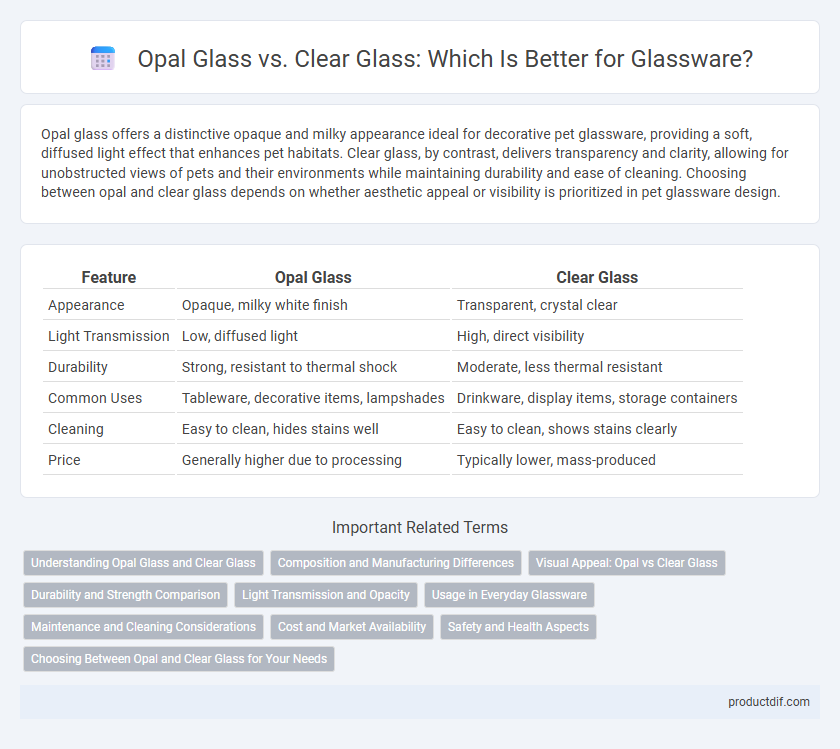Opal glass offers a distinctive opaque and milky appearance ideal for decorative pet glassware, providing a soft, diffused light effect that enhances pet habitats. Clear glass, by contrast, delivers transparency and clarity, allowing for unobstructed views of pets and their environments while maintaining durability and ease of cleaning. Choosing between opal and clear glass depends on whether aesthetic appeal or visibility is prioritized in pet glassware design.
Table of Comparison
| Feature | Opal Glass | Clear Glass |
|---|---|---|
| Appearance | Opaque, milky white finish | Transparent, crystal clear |
| Light Transmission | Low, diffused light | High, direct visibility |
| Durability | Strong, resistant to thermal shock | Moderate, less thermal resistant |
| Common Uses | Tableware, decorative items, lampshades | Drinkware, display items, storage containers |
| Cleaning | Easy to clean, hides stains well | Easy to clean, shows stains clearly |
| Price | Generally higher due to processing | Typically lower, mass-produced |
Understanding Opal Glass and Clear Glass
Opal glass is characterized by its milky, opaque appearance achieved through the addition of specific materials like bone ash or tin oxide during manufacturing, enhancing its aesthetic appeal and diffusing light softly. Clear glass, also known as soda-lime glass, is transparent and composed primarily of silica, soda, and lime, offering maximum clarity and brilliance for visibility and display purposes. Understanding the differences helps in selecting glassware based on desired visual effects, durability, and functionality in applications such as tableware or decorative items.
Composition and Manufacturing Differences
Opal glass is composed of silica mixed with phosphates or fluorides, creating its characteristic milky, opaque appearance, while clear glass primarily consists of silica, soda, and lime for transparency. Manufacturing opal glass involves adding opacifying agents during the molten glass stage to diffuse light, contrasting with clear glass that undergoes a refined melting and annealing process to maintain clarity. These compositional and manufacturing differences influence durability, aesthetics, and applications in glassware production.
Visual Appeal: Opal vs Clear Glass
Opal glass offers a soft, milky translucence that diffuses light, creating an elegant and vintage aesthetic ideal for decorative and ambient settings. Clear glass provides a pristine, transparent surface that highlights the contents with sharp clarity and brilliance, making it perfect for showcasing colorful beverages or intricate designs. The choice between opal and clear glass significantly influences the visual appeal, balancing between subtle sophistication and vibrant clarity.
Durability and Strength Comparison
Opal glass offers higher durability and resistance to thermal shock compared to clear glass, making it ideal for everyday use and sudden temperature changes. Clear glass, while aesthetically transparent, tends to be more brittle and prone to breakage under impact or rapid temperature fluctuations. The density and composition of opal glass enhance its structural strength, providing longer-lasting performance in both kitchenware and decorative applications.
Light Transmission and Opacity
Opal glass features a milky, opaque appearance that significantly diffuses light, resulting in lower light transmission compared to clear glass, which allows maximum light passage due to its transparency. This opacity in opal glass enhances privacy and softens glare, making it ideal for decorative or functional applications requiring diffused illumination. Clear glass excels in clarity and brightness, providing unobstructed visibility and high light transmission, preferred in settings where transparency and natural light are essential.
Usage in Everyday Glassware
Opal glass is favored in everyday glassware for its opaque, milky appearance that diffuses light and hides stains, making it ideal for mugs, tumblers, and dinnerware used frequently. Clear glass, prized for its transparency and brilliance, is commonly used for drinkware and decorative items where visibility of contents and aesthetic appeal are paramount. Both materials cater to different practical needs, with opal glass offering durability and stain concealment, while clear glass emphasizes clarity and elegance in daily use.
Maintenance and Cleaning Considerations
Opal glass requires gentle cleaning with non-abrasive detergents to preserve its smooth, translucent finish, avoiding harsh scrubbing that can cause surface damage. Clear glass is generally more durable and resistant to staining, allowing for more robust cleaning methods, including higher temperatures and stronger cleaning agents. Regular maintenance of opal glass ensures retention of its unique appearance, while clear glass demands less delicate handling but benefits from consistent cleaning to maintain transparency.
Cost and Market Availability
Opal glass typically costs more than clear glass due to its unique milky appearance and production process, which involves adding opacifying agents. Clear glass is generally more affordable and widely available in various shapes and sizes, making it the preferred choice for mass-market applications. Market availability of opal glass is more limited, often targeting niche segments such as decorative items and specialty dinnerware.
Safety and Health Aspects
Opal glass offers enhanced safety benefits compared to clear glass due to its opacity, which reduces glare and UV light transmission, minimizing eye strain and potential skin exposure to harmful rays. This type of glass is less prone to shattering into sharp fragments, making it safer for environments requiring durability and impact resistance. Clear glass, while visually appealing, poses higher risks of breakage and UV exposure, which can lead to increased health concerns in both residential and commercial settings.
Choosing Between Opal and Clear Glass for Your Needs
Opal glass offers a frosted, opaque appearance that diffuses light softly, making it ideal for privacy and decorative purposes, while clear glass provides transparency and clarity, perfect for showcasing contents and maximizing visibility. Consider using opal glass in bathroom accessories or lighting fixtures to create a subtle, elegant glow, whereas clear glass suits kitchenware and display cases where visual access is essential. Selecting between opal and clear glass depends on whether aesthetic diffusion or unobstructed view aligns better with your functional and design requirements.
Opal glass vs Clear glass Infographic

 productdif.com
productdif.com